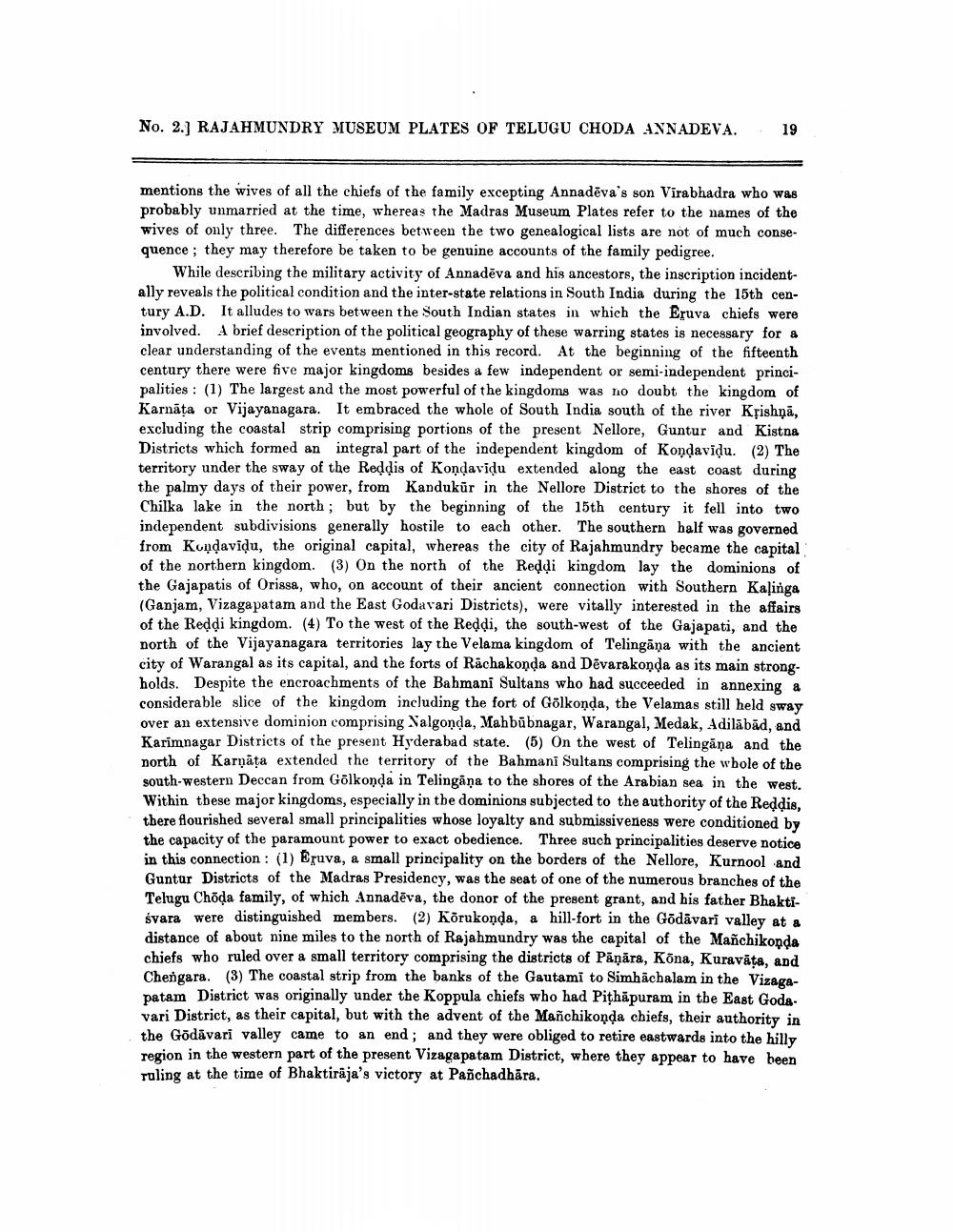________________
No. 2.) RAJAHMUNDRY MUSEUM PLATES OF TELUGU CHODA ANNADEVA.
19
mentions the wives of all the chiefs of the family excepting Annadēva's son Virabhadra who was probably unmarried at the time, whereas the Madras Museum Plates refer to the names of the wives of only three. The differences between the two genealogical lists are not of much consequence ; they may therefore be taken to be genuine accounts of the family pedigree.
While describing the military activity of Annadēva and his ancestors, the inscription incidentally reveals the political condition and the inter-state relations in South India during the 15th century A.D. It alludes to wars between the South Indian states in which the Eruva chiefs were involved. A brief description of the political geography of these warring states is necessary for a clear understanding of the events mentioned in this record. At the beginning of the fifteenth century there were five major kingdoms besides a few independent or semi-independent principalities : (1) The largest and the most powerful of the kingdoms was no doubt the kingdom of Karnāta or Vijayanagara. It embraced the whole of South India south of the river Krishna, excluding the coastal strip comprising portions of the present Nellore, Guntur and Kistna Districts which formed an integral part of the independent kingdom of Kondavidu. (2) The territory under the sway of the Reddis of Kondavidu extended along the east coast during the palmy days of their power, from Kandukūr in the Nellore District to the shores of the Chilka lake in the north ; but by the beginning of the 15th century it fell into two independent subdivisions generally hostile to each other. The southern half was governed from Kundavidu, the original capital, whereas the city of Rajahmundry became the capital of the northern kingdom. (3) On the north of the Redại kingdom lay the dominions of the Gajapatis of Orissa, who, on account of their ancient connection with Southern Kalinga (Ganjam, Vizaga patam and the East Godavari Districts), were vitally interested in the affairs of the Reddi kingdom. (4) To the west of the Reddi, the south-west of the Gajapati, and the north of the Vijayanagara territories lay the Velama kingdom of Telingāṇa with the ancient city of Warangal as its capital, and the forts of Rachakonda and Devarakonda as its main strongholds. Despite the encroachments of the Bahmani Sultans who had succeeded in annexing a considerable slice of the kingdom including the fort of Golkonda, the Velamas still held sway over an extensive dominion comprising Nalgonda, Mahbubnagar, Warangal, Medak, Adilābād, and Karimnagar Districts of the present Hyderabad state. (5) On the west of Telingāna and the north of Karnāța extended the territory of the Bahmani Sultans comprising the whole of the south-western Deccan from Golkonda in Telingāņa to the shores of the Arabian sea in the west. Within these major kingdoms, especially in the dominions subjected to the authority of the Reddis. there flourished several small principalities whose loyalty and submissiveness were conditioned by the capacity of the paramount power to exact obedience. Three such principalities deserve notice in this connection: (1) Eruva, a small principality on the borders of the Nellore, Kurnool and Guntur Districts of the Madras Presidency, was the seat of one of the numerous branches of the Telugu Choda family, of which Annadēva, the donor of the present grant, and his father Bhaktisvara were distinguished members. (2) Korukonda, a hill-fort in the Godavari valley at a distance of about nine miles to the north of Rajahmundry was the capital of the Mañchikonda chiefs who ruled over a small territory comprising the districts of Pāņāra, Kona, Kuravāta, and Chengara. (3) The coastal strip from the banks of the Gautami to Simhachalam in the Vizagapatam District was originally under the Koppula chiefs who had Pithāpuram in the East Goda. vari District, as their capital, but with the advent of the Mañchikonda chiefs, their authority in the Gödāvari valley came to an end ; and they were obliged to retire eastwards into the hilly region in the western part of the present Vizagapatam District, where they appear to have been ruling at the time of Bhaktiraja's victory at Panchadhāra.




